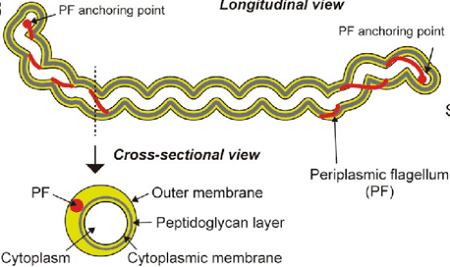Leptospira interrogans complex - Classification, Morphology, Culture, Introduction
Classification of Leptospira interrogans complex
Leptospira interrogans complex is classified as:
Domain: Bacteria
Phylum: Spirochaetota
Class: Spirochaetia
Order: Leptospirales
Family: Leptospiraceae
Genus: Leptospira
Species: interrogans
Leptospira interrogans complex includes leptospires that cause leptospirosis. The disease commonly referred to as swap fever, mud fever, or swine herd’s disease is the most common zoonosis in the world.
Humans become infected through direct or indirect contact with the urine or blood of infected animals. Leptospires enter the human host through breaks in the skin, mucous membranes, or conjunctivae.
Morphology of Leptospira interrogans complex
Morphologically, Leptospira interrogans are right-handed helix, spiral-shaped, thin, delicate, coiled spirochetes measuring 6-20μm x 0.1 μm (l x b) and are obligate aerobes. They are actively motile by means of two periplasmic flagella, each present at the opposite end of the bacteria.
Leptospira interrogans stain poorly with aniline dyes but stain well with silver impregnation methods, such as Levaditis and Pontana’s method of staining. Leptospira interrogans have a distinctive hooked end. Its cell wall contains LPS in OM is a major Ag.

Fig: Leptospira interrogans morphology (Source: ResearchGate)
Culture of Leptospira interrogans complex
Leptospira interrogans are obligate aerobes with an optimum temperature of 25-30°C and an optimum pH of 7.2 to 7.5. They use fatty acids and alcohol as sources of carbon and energy and can be grown in an artificial medium. Korthoff’s medium, Stuart’s medium, and Fetcher’s medium are frequently used media.
The Leptospira interrogans colony growth is very slow- for 13 weeks culture is retained before discarding. It can also be grown on CAM of 10-2- day old chick embryo. Bacteria are seen in the blood of the allantoic sac 4-5 days after inoculation.
Animal inoculation/culture is also done by intraperitoneal inoculation in guinea pugs followed by the collection of heart blood 10 minutes after inoculation. The culture of heart blood yields pure colonies.